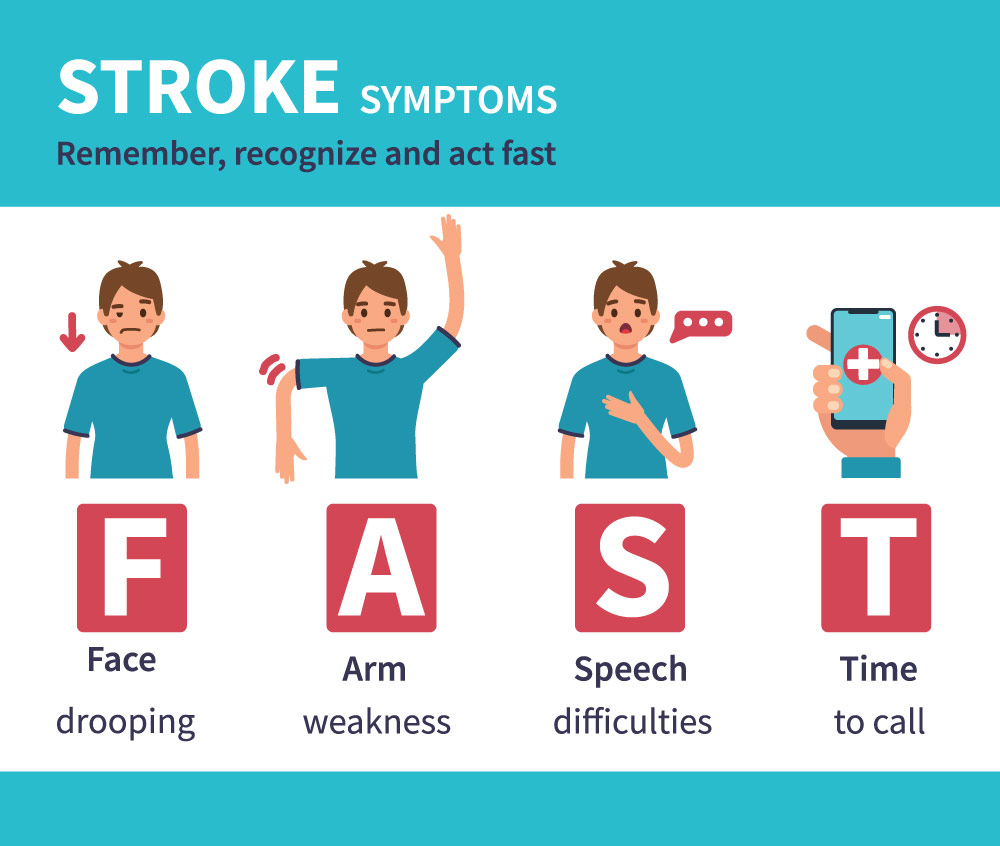What is stroke?
Stroke kills nearly 150,000 of the 860,000 Americans who die of cardiovascular disease each year—that’s 1 in every 19 deaths from all causes.
Related: How to Lower Blood Pressure without Meds.
A stroke, sometimes called a brain attack, happens in one of two ways:
- Ischemic stroke—when the blood supply to the brain is blocked
- Hemorrhagic stroke—when a blood vessel in the brain bursts
A stroke causes brain tissue to die, which can lead to brain damage, disability, and death. Stroke is the fifth leading cause of death in the United States and the leading cause of serious long-term disability. This is disturbing because about 80% of strokes are preventable.
You can greatly reduce your risk for stroke by making lifestyle changes to help control your blood pressure and cholesterol levels and, in some cases, by taking medication.
Conditions That Increase Risk for Stroke
High blood pressure is a leading cause of stroke. It occurs when the pressure of the blood in the arteries is too high.
Many common medical conditions can increase your chances of having a stroke. Work with your health care team to control your risk.
Previous Stroke or Transient Ischemic Attack
If you have already had a stroke or a transient ischemic attack (TIA), also known as a “mini-stroke,” your chances of having another stroke are higher.
High Blood Pressure
High blood pressure is a leading cause of stroke. It occurs when the pressure of the blood in your arteries and other blood vessels is too high.
Related: Thousands of Users Lower Blood Pressure without Medication.
There are often no symptoms of high blood pressure. Get your blood pressure checked often. If you have high blood pressure, lowering your blood pressure through lifestyle changes or medicine can also lower your risk for stroke.
High Cholesterol
Cholesterol is a waxy, fat-like substance made by the liver or found in certain foods. Your liver makes enough for your body’s needs, but we often get more cholesterol from the foods we eat. If we take in more cholesterol than the body can use, the extra cholesterol can build up in the arteries, including those of the brain. This can lead to narrowing of the arteries, stroke, and other problems.
A blood test can tell your doctor if you have high levels of cholesterol and triglycerides (a related kind of fat) in your blood.
Heart Disease
Common heart disorders can increase your risk for stroke. For example, coronary artery disease increases your risk for stroke, because plaque builds up in the arteries and blocks the flow of oxygen-rich blood to the brain. Other heart conditions, such as heart valve defects, irregular heartbeat (including atrial fibrillation), and enlarged heart chambers, can cause blood clots that may break loose and cause a stroke.
Diabetes
Diabetes increases your risk for stroke. Your body needs glucose (sugar) for energy. Insulin is a hormone made in the pancreas that helps move glucose from the food you eat to your body’s cells. If you have diabetes, your body doesn’t make enough insulin, can’t use its own insulin as well as it should, or both.
Diabetes causes sugars to build up in the blood and prevent oxygen and nutrients from getting to the various parts of your body, including your brain. High blood pressure is also common in people with diabetes. High blood pressure is the leading cause of stroke and is the main cause for increased risk of stroke among people with diabetes.1
Talk to your doctor about ways to keep diabetes under control.
Sickle Cell Disease
Sickle cell disease is a blood disorder linked to ischemic stroke that affects mainly black and Hispanic children. The disease causes some red blood cells to form an abnormal sickle shape. A stroke can happen if sickle cells get stuck in a blood vessel and block the flow of blood to the brain.
What are the signs and symptoms of stroke?
An easy way to remember the most common signs of stroke and how to respond is with the acronym F.A.S.T.:

F = Face drooping: Ask the person to smile. Does one side droop?
A = Arm weakness: Ask the person to raise both arms. Does one arm drift downward?
S = Speech difficulty: Ask the person to repeat a simple sentence. Are the words slurred?
T = Time to call 9-1-1: If the person shows any of these signs, call 9-1-1 immediately. Stroke treatment can begin in the ambulance.
Related: Lower Blood Pressure and the Risk of Stroke.
If you think that you or someone you know is having a stroke, call 9-1-1 immediately.
Other common signs of stroke are
- Sudden dizziness, trouble walking, or loss of balance or coordination
- Sudden trouble seeing in one or both eyes
- Sudden severe headache with no known cause
- Sudden numbness of the face, arm, or leg
- Sudden confusion or trouble understanding others
If you think that you or someone you know is having a stroke, call 9-1-1 immediately. Stroke is a medical emergency, and stroke treatment and outcomes depend on how fast you get to the hospital and the type of stroke the person had.
When you are transported by ambulance, first responders may be able to start your treatment right away and can alert the hospital that a stroke patient is on the way. This notification gives the hospital’s medical team time to prepare equipment and medicines you may need.
Lower Your Risk for Stroke
Learn the ABCS of stroke prevention:
Aspirin: Aspirin may help lower your risk for stroke.
Blood Pressure: Control your blood pressure.
Cholesterol: Control your cholesterol.
Smoking: Quit smoking or don’t start.
Source: Center for Disease Control and Prevention
Stroke Prevention
While everyone is at risk for stroke, you have the power to help protect yourself. Start by following the 10 tips listed here, getting regular checkups and treatment for any existing conditions, and adopting a healthy lifestyle.
10 tips to reduce your risk of stroke
Related: U.S. Military Accidentally Cures Hypertension.
- Control high blood pressure (hypertension). Know your numbers and keep them low.
- Quit tobacco. Smoking raises the risk of stroke.
- Control diabetes. You can manage diabetes with diet, exercise, weight control and medication.
- Manage a healthy weight. Being overweight contributes to other stroke risk factors such as high blood pressure, cardiovascular disease and diabetes. Weight loss of as little as 10 pounds may lower your blood pressure and improve your cholesterol levels.
- Eat a diet rich in fruits and vegetables. A diet containing five or more daily servings of fruits or vegetables may reduce your risk of stroke.
- Exercise. Exercise can lower your blood pressure, increase your level of high-density lipoprotein cholesterol, and improve the overall health of your blood vessels and heart. It also helps you lose weight, control diabetes and reduce stress.
- Drink alcohol in moderation, if at all. Heavy alcohol consumption increases your risk of high blood pressure, ischemic strokes and hemorrhagic strokes.
- Treat obstructive sleep apnea, if present. Your health care provider may recommend an overnight oxygen assessment to screen for obstructive sleep apnea (OSA). If obstructive sleep apnea is detected, it may be treated by giving you oxygen at night or having you wear a small device in your mouth.
- Avoid illicit drugs. Certain street drugs, such as cocaine and methamphetamines, are established risk factors for a transient ischemic attack (TIA) or a stroke.
- Manage other medical conditions. If you have any of these conditions, seek treatment to help reduce your risk of stroke: high cholesterol, carotid artery disease, peripheral artery disease, atrial fibrillation (AFib), heart disease or sickle cell disease.
Stroke risk factors not in your control
Some people are at greater risk, but anyone can have a stroke. While you can’t control these risk factors, knowing about them can help you focus more on the factors you are able to change:
- Age. Although stroke is more common among the elderly, people under 65 — including babies and children — can also have strokes.
- Gender. Each year, stroke kills more women than men. Factors that may increase stroke risks for women include pregnancy, gestational diabetes, history of pre-eclampsia/eclampsia, oral contraceptive use, smoking and post-menopausal hormone therapy.
- Race. African-Americans have a much higher risk of death from a stroke than Caucasians.
- Family history. If your parent, grandparent, sister or brother has had a stroke, especially before age 65, you may be at a greater risk.
- Prior stroke, TIA or heart attack. A person who has had any of these before is at a much higher risk of having another stroke.
- Other risk factors. Other factors often linked to higher stroke risks include having a lower income, drug and alcohol abuse, and not maintaining healthy sleep habits.
Source: Mayo Clinic
[su_youtube url=”https://www.youtube.com/watch?v=-NJm4TJ2it0″ title=”What happens during a stroke?”]










